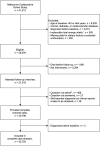Diet and risk of Barrett's oesophagus: Melbourne collaborative cohort study
- PMID: 35837679
- PMCID: PMC10011587
- DOI: 10.1017/S0007114522002112
Diet and risk of Barrett's oesophagus: Melbourne collaborative cohort study
Abstract
Barrett's oesophagus (BE) is the precursor of oesophageal adenocarcinoma, which has become the most common type of oesophageal cancer in many Western populations. Existing evidence on diet and risk of BE predominantly comes from case-control studies, which are subject to recall bias in measurement of diet. We aimed to investigate the potential effect of diet, including macronutrients, carotenoids, food groups, specific food items, beverages and dietary scores, on risk of BE in over 20 000 participants of the Melbourne Collaborative Cohort Study. Diet at baseline (1990-1994) was measured using a food frequency questionnaire. The outcome was BE diagnosed between baseline and follow-up (2007-2010). Logistic regression models were used to estimate OR and 95 % CI for diet in relation to risk of BE. Intakes of leafy vegetables and fruit were inversely associated with risk of BE (highest v. lowest quartile: OR = 0·59; CI: 0·38, 0·94; P-trend = 0·02 and OR = 0·58; CI: 0·37, 0·93; P-trend = 0·02 respectively), as were dietary fibre and carotenoids. Stronger associations were observed for food than the nutrients found in them. Positive associations were observed for discretionary food (OR = 1·54; CI: 0·97, 2·44; P-trend = 0·04) and total fat intake (OR per 10 g/d = 1·11; CI: 1·00, 1·23), the association for fat was less robust in sensitivity analyses. No association was observed for meat, protein, dairy products or diet scores. Diet is a potential modifiable risk factor for BE. Public health and clinical guidelines that incorporate dietary recommendations could contribute to reduction in risk of BE and, thereby, oesophageal adenocarcinoma.
Keywords: Barrett’s oesophagus; Carotenoids; Dietary fibre; Fruit; Gastroesophageal reflux; Oesophageal adenocarcinoma; Vegetable.
Figures


References
-
- Coleman HG, Xie SH & Lagergren J (2018) The epidemiology of esophageal adenocarcinoma. Gastroenterology 154, 390–405. - PubMed
-
- Coleman HG, Bhat S, Murray LJ, et al. (2011) Increasing incidence of Barrett’s oesophagus: a population-based study. Eur J Epidemiol 26, 739–745. - PubMed
-
- Kendall BJ & Whiteman DC (2006) Temporal changes in the endoscopic frequency of new cases of Barrett’s esophagus in an Australian health region. Am J Gastroenterol 101, 1178–1182. - PubMed
-
- Schneider JL & Corley DA (2017) The troublesome epidemiology of Barrett’s esophagus and esophageal adenocarcinoma. Gastrointest Endosc Clin N Am 27, 353–364. - PubMed
LinkOut - more resources
Full Text Sources

